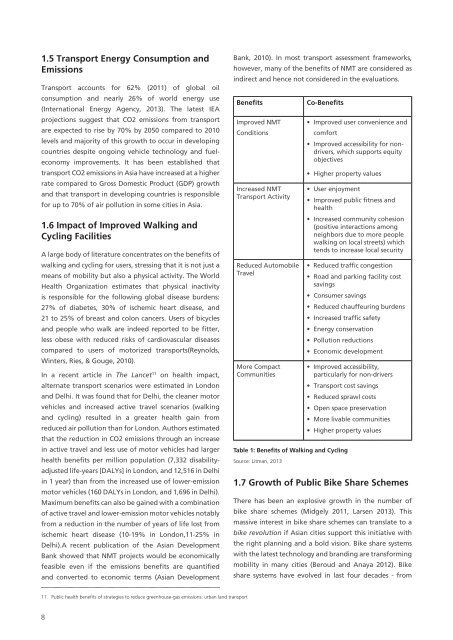Promoting Non-motorised Transport in Asian Cities
Shakti Sustainable Energy Foundation conducted a study to assess the viability of promoting non-motorised transport in Asian cities. As part of the study, they undertook a project – Nehru Place Placemaking. See more at: http://shaktifoundation.in/report/promoting-non-motorised-transport-asian-cities-policymakers-toolbox/
Shakti Sustainable Energy Foundation conducted a study to assess the viability of promoting non-motorised transport in Asian cities. As part of the study, they undertook a project – Nehru Place Placemaking. See more at: http://shaktifoundation.in/report/promoting-non-motorised-transport-asian-cities-policymakers-toolbox/
Create successful ePaper yourself
Turn your PDF publications into a flip-book with our unique Google optimized e-Paper software.
1.5 <strong>Transport</strong> Energy Consumption and<br />
Emissions<br />
<strong>Transport</strong> accounts for 62% (2011) of global oil<br />
consumption and nearly 26% of world energy use<br />
(International Energy Agency, 2013). The latest IEA<br />
projections suggest that CO2 emissions from transport<br />
are expected to rise by 70% by 2050 compared to 2010<br />
levels and majority of this growth to occur <strong>in</strong> develop<strong>in</strong>g<br />
countries despite ongo<strong>in</strong>g vehicle technology and fueleconomy<br />
improvements. It has been established that<br />
transport CO2 emissions <strong>in</strong> Asia have <strong>in</strong>creased at a higher<br />
rate compared to Gross Domestic Product (GDP) growth<br />
and that transport <strong>in</strong> develop<strong>in</strong>g countries is responsible<br />
for up to 70% of air pollution <strong>in</strong> some cities <strong>in</strong> Asia.<br />
1.6 Impact of Improved Walk<strong>in</strong>g and<br />
Cycl<strong>in</strong>g Facilities<br />
A large body of literature concentrates on the benefits of<br />
walk<strong>in</strong>g and cycl<strong>in</strong>g for users, stress<strong>in</strong>g that it is not just a<br />
means of mobility but also a physical activity. The World<br />
Health Organization estimates that physical <strong>in</strong>activity<br />
is responsible for the follow<strong>in</strong>g global disease burdens:<br />
27% of diabetes, 30% of ischemic heart disease, and<br />
21 to 25% of breast and colon cancers. Users of bicycles<br />
and people who walk are <strong>in</strong>deed reported to be fitter,<br />
less obese with reduced risks of cardiovascular diseases<br />
compared to users of motorized transports(Reynolds,<br />
W<strong>in</strong>ters, Ries, & Gouge, 2010).<br />
In a recent article <strong>in</strong> The Lancet 11 on health impact,<br />
alternate transport scenarios were estimated <strong>in</strong> London<br />
and Delhi. It was found that for Delhi, the cleaner motor<br />
vehicles and <strong>in</strong>creased active travel scenarios (walk<strong>in</strong>g<br />
and cycl<strong>in</strong>g) resulted <strong>in</strong> a greater health ga<strong>in</strong> from<br />
reduced air pollution than for London. Authors estimated<br />
that the reduction <strong>in</strong> CO2 emissions through an <strong>in</strong>crease<br />
<strong>in</strong> active travel and less use of motor vehicles had larger<br />
health benefits per million population (7,332 disabilityadjusted<br />
life-years [DALYs] <strong>in</strong> London, and 12,516 <strong>in</strong> Delhi<br />
<strong>in</strong> 1 year) than from the <strong>in</strong>creased use of lower-emission<br />
motor vehicles (160 DALYs <strong>in</strong> London, and 1,696 <strong>in</strong> Delhi).<br />
Maximum benefits can also be ga<strong>in</strong>ed with a comb<strong>in</strong>ation<br />
of active travel and lower-emission motor vehicles notably<br />
from a reduction <strong>in</strong> the number of years of life lost from<br />
ischemic heart disease (10-19% <strong>in</strong> London,11-25% <strong>in</strong><br />
Delhi).A recent publication of the <strong>Asian</strong> Development<br />
Bank showed that NMT projects would be economically<br />
feasible even if the emissions benefits are quantified<br />
and converted to economic terms (<strong>Asian</strong> Development<br />
Bank, 2010). In most transport assessment frameworks,<br />
however, many of the benefits of NMT are considered as<br />
<strong>in</strong>direct and hence not considered <strong>in</strong> the evaluations.<br />
Benefits<br />
Improved NMT<br />
Conditions<br />
Increased NMT<br />
<strong>Transport</strong> Activity<br />
Reduced Automobile<br />
Travel<br />
More Compact<br />
Communities<br />
Co-Benefits<br />
• Improved user convenience and<br />
comfort<br />
• Improved accessibility for nondrivers,<br />
which supports equity<br />
objectives<br />
• Higher property values<br />
• User enjoyment<br />
• Improved public fitness and<br />
health<br />
• Increased community cohesion<br />
(positive <strong>in</strong>teractions among<br />
neighbors due to more people<br />
walk<strong>in</strong>g on local streets) which<br />
tends to <strong>in</strong>crease local security<br />
• Reduced traffic congestion<br />
• Road and park<strong>in</strong>g facility cost<br />
sav<strong>in</strong>gs<br />
• Consumer sav<strong>in</strong>gs<br />
• Reduced chauffeur<strong>in</strong>g burdens<br />
• Increased traffic safety<br />
• Energy conservation<br />
• Pollution reductions<br />
• Economic development<br />
• Improved accessibility,<br />
particularly for non-drivers<br />
• <strong>Transport</strong> cost sav<strong>in</strong>gs<br />
• Reduced sprawl costs<br />
• Open space preservation<br />
• More livable communities<br />
• Higher property values<br />
Table 1: Benefits of Walk<strong>in</strong>g and Cycl<strong>in</strong>g<br />
Source: Litman, 2013<br />
1.7 Growth of Public Bike Share Schemes<br />
There has been an explosive growth <strong>in</strong> the number of<br />
bike share schemes (Midgely 2011, Larsen 2013). This<br />
massive <strong>in</strong>terest <strong>in</strong> bike share schemes can translate to a<br />
bike revolution if <strong>Asian</strong> cities support this <strong>in</strong>itiative with<br />
the right plann<strong>in</strong>g and a bold vision. Bike share systems<br />
with the latest technology and brand<strong>in</strong>g are transform<strong>in</strong>g<br />
mobility <strong>in</strong> many cities (Beroud and Anaya 2012). Bike<br />
share systems have evolved <strong>in</strong> last four decades - from<br />
11. Public health benefits of strategies to reduce greenhouse-gas emissions: urban land transport<br />
8

















